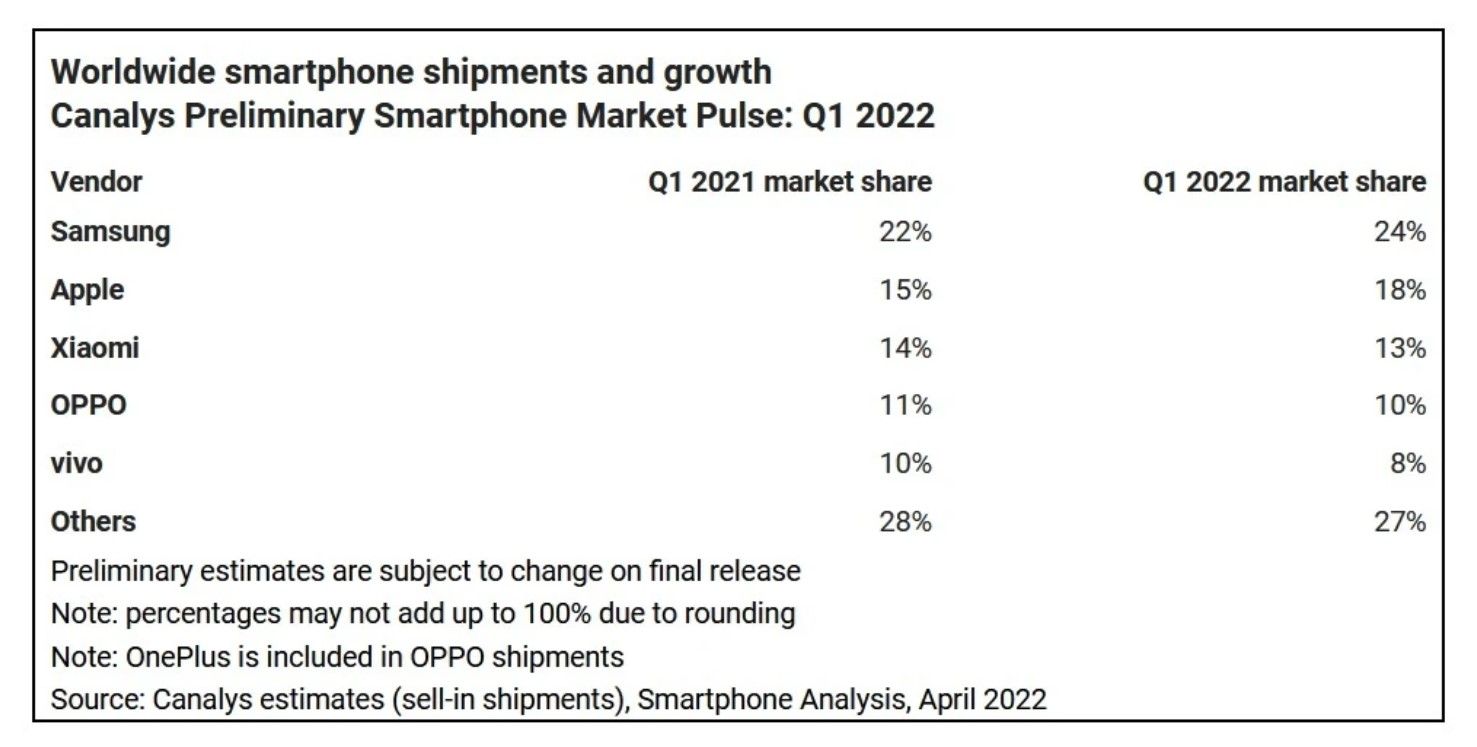What Is The Market Share Of iPhone, Samsung, Xiaomi, Oppo, And Other Smartphone Manufacturers In The First Quarter Of 2022?
Among all the unprecedented events happening in the world today, you may have forgotten that the first quarter of 2022 is over. We are now in the second quarter of the year, and we can guess that we will see the release of profit reports of various companies in the first quarter of the year in the next few weeks.
According to Canaliz, smartphone sales fell 11 percent in the first quarter. Canaliz Technology Market Analyst Company presented its first quarterly report in 2022 on global sales of smartphones in January, February and March.
Overall, smartphones shipped to manufacturers fell 11 percent, which could be due to a seasonal drop in demand for smartphones and a weak global economy. However, Samsung could continue its growth trend, increasing its market share in the first quarter of the year from 22% to 24%.
In the first quarter of 2022, Samsung unveiled the S22 series handsets, including the flagship S22 Ultra.
The company also launched a new series of Android tablets, the Galaxy Tab S8.
The popular A-Series also saw the introduction of new products such as the A53 and A33.
Samsung mid-range phones are known for their large screens, powerful cameras, and powerful batteries.
Samsung’s next big unveiling will be the company’s clamshell phones. The Galaxy Z Flip 4 and Galaxy Z Fold 4 are likely to be unveiled in the third quarter of this year. The pre-sale year of both models started in the third quarter of the year.

You’ve probably guessed which phone maker in this list is behind Samsung.
With an 18% market share in the first quarter of this year and a growth rate of 3% compared to the first quarter of last year, it was the second best-selling handset maker globally.
During the first quarter of 2022, Apple unveiled the iPhone SE 3. However, all the evidence shows that sales of Apple products have been “sluggish,” as Mingchi Koo, a well-known analyst, described them. On the other hand, Canaliz praised the cheap and new iPhone and said:
The iPhone SE 3 plays a significant role in Apple’s mobility in the mid-range phone market. Due to the similar price to the previous generation, this phone uses more up-to-date chips and better battery performance. Also, buyers of this phone can now use the 5G capability.
Apple is expected to start selling the iPhone 14 series later in the third quarter.
Reports indicate we will see an exciting change in the supply of Apple products; Among other things, despite the introduction of 4 products from the iPhone 14 family, there will be no more news about the iPhone Mini. Apple is expected to unveil the 1.6-inch iPhone 14 and iPhone 14 Pro and the 6.7-inch iPhone 14 Max and iPhone 14 Max Pro.
In the first quarter of 2022, Xiaomi lost 13 percent of its market share and now accounts for 13 percent of smartphone sales. In fourth place is Oppo, which has also lost 1% of the market share, leaving Oppo with only 10% of global smartphone sales.
This statistic also includes the sale of Van Plus. It should note that this decrease in Oppo sales has occurred despite the introduction of the company’s new flagship phone, the Find X5 Pro.
Quaid continues to influence global smartphone sales
At the bottom of the list is Oppo Cave, Vivo. In addition to OnePlus & Riley and IQOO, these companies are owned by the Chinese manufacturing group BBK Electronics.
“Analysis of market conditions in the first quarter of 2022,” said Nicole Peng, an analyst at Canaliz. In the first quarter of the new year, Vivo’s market share of smartphones was 8%, a 2% decrease in their market share. In other words, the overall share of Baby Electronics in the smartphone market, excluding all related phone brands, has fallen from 28% last year to 27%.
The global smartphone market has been hit by instability in the business environment. Markets saw an increase in cases of Quid after the emergence of the Omicron strain;
However, the low number of patients admitted and the high rate of vaccination caused the activity of consumers to return to normal quickly. The sellers are uncertain due to Russia’s war with Ukraine, the quarantine of Chinese cities, and the threat of inflation.
Peng concludes that all of this, in addition to the traditional drop-in buyer demand at this time of year, has led to a decline in smartphone sales. In addition to focusing on long-term plans, salespeople need to prepare for new opportunities and risks.
The good news is that the painful shortage of parts will end sooner than previously anticipated during the current difficult world situation. It will undoubtedly help reduce the pressures of high costs.